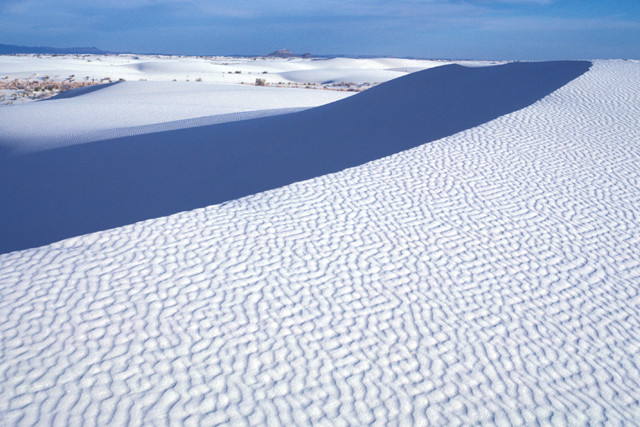
by U.S. Geological Survey Thursday, June 14, 2018
Robert D. Crangle Jr., mineral commodity specialist for the U.S. Geological Survey, compiled the following information on gypsum, an essential commodity for the construction and horticultural industries.

The sand dunes in White Sands National Monument are made of gypsum. Credit: ©Bruce Molnia, Terra Photographics/ESW Image Bank
You may not realize it, but the walls of your office are probably made from a mineral: gypsum. Gypsum is an abundant, evaporite-derived sedimentary mineral with deposits located throughout the world. It is often associated with paleo-environmental lake and marine environments. In its pure form, gypsum consists of calcium sulfate dihydrate, although most crude gypsum naturally occurs in combination with anhydrite, clay, dolomite and/or limestone.
The vast majority of gypsum consumed in the United States is used in the manufacture of construction products like wallboard (also known as drywall, rock lath, Sheetrock, Gibraltar Board, gypsum-board and Gyproc) and plaster products. It’s used in these products because of its widespread availability, low cost and fire-retardant properties. Gypsum is also used prominently in the production of cement and for agricultural applications, where it acts as a soil amendment, a conditioner and a fertilizer. Smaller quantities of high-purity gypsum are used in metal smelting and glassmaking.
U.S. consumption of gypsum has decreased by 50 percent since 2006 due to declines in the residential and commercial construction sectors resulting from the recent economic downturn. But U.S. and global consumption of gypsum is expected to increase in 2011 owing to the predicted increases in the residential and commercial construction sectors. International gypsum consumption, particularly in China and India, has grown considerably in the last 10 years and is expected to continue to expand as a result of a growing cultural shift toward gypsum building products.
Most crude gypsum produced in the United States originates from open-pit mines west of the Mississippi River. Processing is typically limited to drying, crushing, screening and calcining. Accompanying, and in many instances displacing, traditionally mined gypsum is large-scale manufacturing of synthetic gypsum, most of which is derived from the desulfurization of flue gases released from coal-fired electric power plants. This synthetic form of gypsum is mineralogically identical to its naturally occurring counterpart, but is available at a fraction of the cost.
For more information on gypsum and other mineral resources, visit: minerals.usgs.gov/minerals.
Gypsum production and consumption
Preliminary data for 2010 showed 45 mines produced 9.0 million metric tons of crude gypsum in the United States.
China, Iran, Spain, and the United States are the world’s leading gypsum producers.
In 1990, less than 5 percent of the U.S. gypsum supply originated from synthetic gypsum. By 2010, synthetic gypsum accounted for nearly 40 percent of the country’s domestic gypsum consumption.
Fun facts
Calcination (low-temperature processing that removes water from the mineral) of 1 cubic meter of gypsum yields almost 428 liters (113 gallons) of water. Calcination of gypsum results in anhydrite, which can be remixed with water and hardened to form a variety of shapes and sizes, such as wallboard.
Gypsum has been used by smugglers to make a variety of objects, including hollow statues and figurines, with the intention of evading the scrutiny of customs inspectors.
As a result of its high weight, low cost and widespread availability, 80 percent of gypsum is sold and consumed in the country where it is produced.
Following the devastating London Fire of 1666, the King of France required all construction to use gypsum, also known as “Plaster of Paris,” as a means of fire protection.
© 2008-2021. All rights reserved. Any copying, redistribution or retransmission of any of the contents of this service without the expressed written permission of the American Geosciences Institute is expressly prohibited. Click here for all copyright requests.